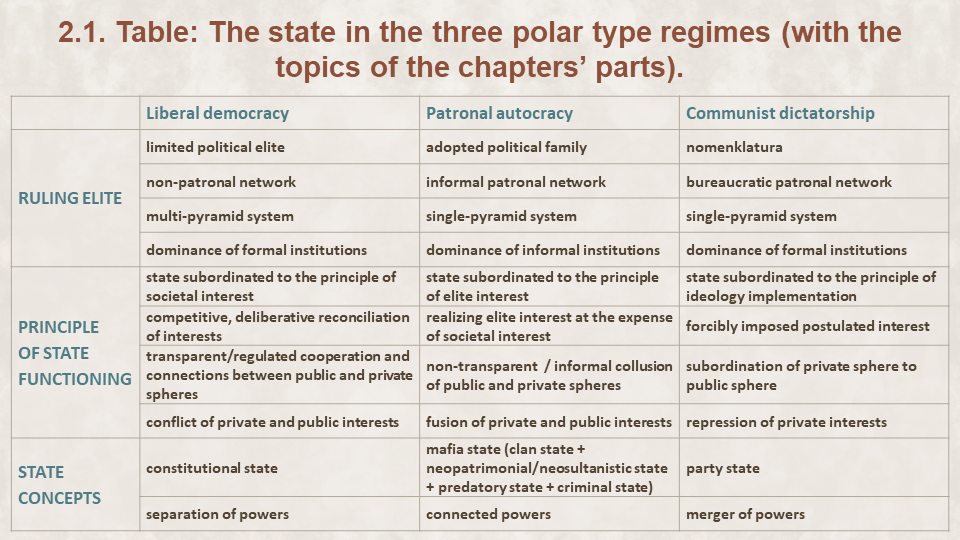This chapter deals with comparative conceptualization of the state. It will unfold along the lines of Table 2.1, which contains much of the concepts that will be introduced, sorted according to the three polar types from the six ideal type regimes of the triangular conceptual space.

The chapter starts out by introducing the most basic concepts of our framework, needed both for the development of a coherent conceptual framework in general and the state concepts to be defined in this chapter in particular. Part 2.2 includes, first, the definition of regime and state, which also requires the clarification of the way we are going to use terms such as “violence,” “coercion,” and “voluntary action.” Second, in the same part we provide general definitions for the terms “elite” and “ruling elite,” as well as a description of the networks of ruling elites in the three polar type regimes. We will explain in what sense we use the terms “formal,” “informal,” “patronal” and “non-patronal,” and describe the stratification of patronal pyramids in terms of their layers and tiers.
In Part 2.3, we provide a typology of the basic principles a state can run on. As we will show, the different principles of state functioning immediately define groups for the various labels that have been given to states in the literature. However, since this toolkit is developed primarily for the post-communist region, we mainly focus on the concepts that presume the so-called principle of elite interest (or the twin motives of power monopolization and wealth accumulation). Part 2.4 is devoted to these state concepts, some of which can be seen in Table 2.1 in the fifth cell for patronal autocracy. To create a logical ordering of the concepts that have been developed for such states but also used in a disorganized manner, we will use so-called interpretative layers, based on four key aspects of governance we will differentiate. Every state concept will be sharpened to refer to only 1-1 aspect of state functioning, so the resultant conceptual tools can be used as parts of the same analytical framework, allowing for the denomination and comparison of a great variety of states.
Having defined the monopoly of the legitimate use of violence as the fundamental feature of an ideal typical state, we devote Part 2.5 to the challenges to this monopoly. First, we describe state failure as it happened in the post-communist region after the collapse of the Soviet Union, leading to oligarchic anarchy in countries like Russia and Ukraine. Second, we provide a typology for the legitimate use of violence, also reflecting on the relationship between formal state actors and informal (and often illegal) actors of the criminal underworld, as well as the phenomenon of sub-sovereign mafia state.
Finally, Part 2.6 provides a summary that also extends the previous discussion in important ways. Building on Frye and Shleifer’s often-cited article, “The Invisible Hand and the Grabbing Hand,” we present six of the most important state types in the region in a comparative manner. This way, the similarities as well as differences of state types that are often confused—such as the mafia state and the developmental state—can be observed, while we can also discuss coordinated and uncoordinated predation in mafia states and failed states, respectively.